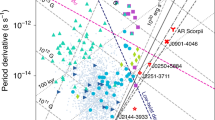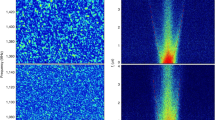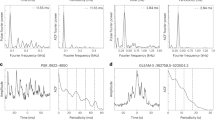Abstract
Radio pulsars are thought to born with spin periods of 0.02–0.5 s and space velocities of 100–1,000 km s−1, and they are inferred to have initial dipole magnetic fields of 1011–1013 G (1–5). The average space velocity of their progenitor stars is less than 15 km s−1, which means that pulsars must receive a substantial ‘kick’ at birth. Here we propose that the birth characteristics of pulsars have a simple physical connection with each other. Magnetic fields maintained by differential rotation between the core and envelope of the progenitor would keep the whole star in a state of approximately uniform rotation until10 years before the explosion. Such a slowly rotating core has 1,000 times less angular momentum than required to explain the rotation of pulsars. The specific physical process that ‘kicks’ the neutron star at birth has not been identified, but unless its force is exerted exactly head-on6 it will also cause the neutron star to rotate. We identify this process as the origin of the spin of pulsars. Such kicks may cause a correlation between the velocity and spin vectors of pulsars. We predict that many neutron stars are born with periods longer than 2 s, and never become radio pulsars.
This is a preview of subscription content, access via your institution
Access options
Subscribe to this journal
Receive 51 print issues and online access
$199.00 per year
only $3.90 per issue
Buy this article
- Purchase on Springer Link
- Instant access to full article PDF
Prices may be subject to local taxes which are calculated during checkout

Similar content being viewed by others
References
Narayan, R. The birthrate and initial spin period of single radio pulsars. Astrophys. J. 319, 162–179 (1987).
Bhattacharya, D., Wijers, R. A. M. J., Hartman, J. W. & Verbunt, F. On the decay of the magnetic fields of single radio pulsars. Astron. Astrophys. 254, 198–212 (1992).
Lorimer, D. R., Bailes, M., Dewey, R. J. & Harrison, P. A. Pulsar statistics — The birth rates and initial spin periods of radio pulsars. Mon. Not. R. Astron. Soc. 263, 403–415 (1993).
Lyne, A. G. & Lorimer, D. R. High birth velocities of radio pulsars. Nature 369, 127–129 (1994).
Hansen, B. M. S. & Phinney, E. S. The pulsar kick velocity distribution. Mon. Not. R. Astron. Soc. 291, 569–577 (1997).
Burrows, A., Hayes, J. & Fryxell, B. A. On the nature of core-collapse supernova explosions. Astrophys. J. 450, 830–850 (1995).
Langer, N., Fliegner, J., Heger, A. & Woosley, S. E. Nucleosynthesis in rotating massive stars. Nucl. Phys. A 621, 475c–466c (1997).
Thompson, M. J.et al. Solar internal rotation and dynamics from GONG frequency splittings. Science 272, 1300–1305 (1996).
Corbard, T.et al. Solar internal rotation from LOWL data. A 2D regularized least-squares inversion using B-splines. Astron. Astrophys. 324, 298–310 (1997).
Spruit, H. C., Knoblock, E. & Roxburgh, I. W. Internal rotation of the sun. Nature 304, 520–522 (1983).
Endal, A. S. & Sofia, S. The evolution of rotating stars. II — Calculations with time-dependent redistribution of angular momentum for 7- and 10-solar-mass stars. Astrophys. J. 220, 279–290 (1978).
Mestel, L. Rotation and stellar evolution. Mon. Not. R. Astron. Soc. 113, 735 (1953).
Charbonneau, P. & MacGregor, K. B. Angular momentum transport in magnetized stellar radiative zones. I — Numerical solutions to the core spin-up model problem. Astrophys. J. 387, 639–661 (1992).
Acheson, D. J. On the instability of toroidal magnetic fields and differential rotation in stars. Phil. Trans. R. Soc. Lond. 289, 459–500 (1978).
Balbus, S. A. General local stability criteria for stratified, weakly magnetized rotating systems. Astrophys. J. 453, 380–383 (1995).
Tout, C. A. & Pringle, J. E. accretion disc velocity — A simple model for a magnetic dynamo. Mon. Not. R. Astron. Soc. 256, 269–276 (1992).
Regös, E. & Tout, C. A. The effect of magnetic fields in common-envelope evolution on the formation of cataclysmic variables. Mon. Not. R. Astron. Soc. 273, 146–156 (1995).
Slettebak, A. in Stellar Rotation (ed. Slettebak, A.) 3–8 (Reidel, Dordrecht, 1970).
Herant, M., Benz, W. & Colgate, S. Postcollapse hydrodynamics of SN 1987A — Two-dimensional simulations of the early evolution. Astrophys. J. 395, 642–653 (1992).
Burrows, A. & Hayes, J. Pulsar recoil and gravitational radiation due to asymmetrical stellar collapse and explosion. Phys. Rev. Lett. 76, 352–355 (1996).
Janka, H.-Th. & Müller, E. Neutrino heating, convection, and the mechanism of Type-II supernova explosions. Astron. Astrophys. 306, 167–198 (1996).
Janka, H.-Th. & Müller, E. Neutron star recoils from anisotropic supernovae. Astron. Astrophys. 290, 496–502 (1994).
Janka, H.-Th. & Müller, E. Neutron star kicks and multi-dimensional supernova models. Ann. NY Acad. Sci. 759, 269–274 (1995).
Keil, W., Janka, H.-Th. & Müller, E. Ledoux convection in protoneutron stars — clue to supernova nucleosynthesis? Astrophys. J. 473, L111–L114 (1996).
Thompson, C. & Duncan, R. C. Neutron star dynamos and the origins of pulsar magnetism. Astrophys. J. 408, 194–217 (1993).
Burrows, A. Convection and the mechanism of type II supernovae. Astrophys. J. 318, L57–L61 (1987).
Horowitz, C. J. & Li, G. Cumulative parity violation in supernovae.Preprint hep-ph/9701214 ((1997).
Lai, D. & Qian, Y.-Z. Neutrino transport in strongly magnetized proto-neutron stars and the origin of pulsar kicks: I. The effect of parity violation in weak interactions. Astrophys. J.(submitted): preprint astro-ph/9802344 ((1998).
Haberl, F., Motch, C., Buckley, D. A. H., Zickgraf, F.-J. & Pietsch, W. RXJ0720.4-3125: strong evidence for an isolated pulsating neutron star. Astron. Astrophys. 326, 662–668 (1997).
Mergehetti, S., Stella, L. & Israel, G. L. Recent results on anomalous X-ray pulsars.Preprint astro-ph/97122254 ((1997).
Acknowledgements
E.S.P. thanks G. Soberman and S. Woosley for the sequences of stellar models used in the integrations. E.S.P. is supported in part by the US NSF and NASA, and thanks ESO for hospitality and support.
Author information
Authors and Affiliations
Corresponding author
Rights and permissions
About this article
Cite this article
Spruit, H., Phinney, E. Birth kicks as the origin of pulsar rotation. Nature 393, 139–141 (1998). https://doi.org/10.1038/30168
Received:
Accepted:
Issue Date:
DOI: https://doi.org/10.1038/30168
This article is cited by
-
Evidence for three-dimensional spin–velocity alignment in a pulsar
Nature Astronomy (2021)
-
Gamma-ray astrophysics in the MeV range
Experimental Astronomy (2021)
-
A polarized view of the hot and violent universe
Experimental Astronomy (2021)
-
Hydrodynamics of core-collapse supernovae and their progenitors
Living Reviews in Computational Astrophysics (2020)
-
Rotating stars in relativity
Living Reviews in Relativity (2017)
Comments
By submitting a comment you agree to abide by our Terms and Community Guidelines. If you find something abusive or that does not comply with our terms or guidelines please flag it as inappropriate.



